راه اندازی ماژول USB HOST تراشه CH376S با آردوینو

توضیح پروژه:
فلش مموری (USB Flash Drive) یکی از جدیدترین حافظه های موجود برای ذخیره سازی اطلاعات از طریق کامپیوتر است ، با این تفاوت که حجم ظرفیت آن به مراتب بیشتر از CD است. فلش مموری ها در انواع گوناگون و برای مصارف مختلف ساخته شده اند . حافظه های فلش به دلیل سرعت بالای آنها در ثبت اطلاعات و همچنین استفاده فوق العاده آسان بسیار پر فروش و پر طرف دار می باشند . از این رو در دوربین های دیجیتالی ، تلفن همراه و سایر دستگاه ها شاهد استفاده روز افزون از آنها هستیم.
برای ارتباط سخت افزاری بین فلش مموری و میکروکنترلر ها و برای نوشتن-خواندن یک فایل بروی فلش مموری باید از پروتکل USB در مد HOST استفاده نمائیم. برای استفاده از فایل های ذخیره شده بروی حافظه فلش توسط یک کامپیوتر، باید اطلاعات را طبق فرمت استاندارد FAT32 در آورده و آن را بروی فلش مموری ذخیره نمائیم تا پس از اتصال فلش مموری به پورت USB، کامپیوتر بتواند فایل های ذخیره شده را نمایش دهد. در این پروژه برای ارتباط با حافظه فلش (USB Flash Drive) از ماژول CH376 استفاده شده است. این ماژول از فرمت های استاندارد ذخیره سازی FAT12 – FAT16 – FAT32 برخوردار است. در این پروژه برای ارتباط با ماژول USB HOST توسط پروتکل سریال با آردوینو استفاده شده است.
ماژول CH376:
ماژول USB HOST CH376 یک کنترل کننده مدیریت فایل است. میکروکنترلرها می توانند از این تراشه برای خواندن و نوشتن بر روی USB flash disk یا SD کارت استفاده کنند. ماژول CH376 از مد USB-Deviceو USB-Hostپشتیبانی می کند. دستگاه ذخیره سازی گسترده USB و سیستم عامل پروتکل های ارتباطی SDکارت و سیستم عامل مدیریت فایل FAT12/FAT16/FAT32 در این ماژول تعبیه شده است. ماژول CH376اغلب از دستگاه های ذخیره سازی USB،هارد دیسک USB و SD کارت که شامل SD کارت استاندارد و SD-HC است ، پشتیبانی می کند.از وسایلی که قابلیت اتصال به این ماژول را دارند می توان به موس ،کیبورد،پرینتر ، کول دیسک و هارد به عنوان نمونه اشاره کرد. ماژول CH376 سه نوع از رابط های ارتباطی را پشتیبانی می کند.
- پورت موازی ۸بیتی
- رابط SPI
- رابط سریال آسنکرون UART
مشخصات ماژول CH376:
- پشتیبانی از سرعت ۵Mbps و ۱۲Mbps سازگار با USB V 2.0 و تنها به کریستال و خازن خارجی نیاز دارد.
- کارکرد در دو مد USB-Host و USB-Device ، تغییر وضعیت خودکار بین این دو مد
- پشتیبانی از انتقال کنترل USB Device و انتقال وقفه
- آشکارسازی اتوماتیک به هنگام وصل کردن به پریز برق و جداکردن USB و ارسال پیام به USB-Host
- تامین ارتباط SPI hostبا فرکانس ۶MHZ و پشتیبانی از SDکارت ،MMCکارت و TFکارت که با این پروتکل سازگار است.
- مد USB-Device سازگار با تراشه CH372 ، مد USB-host با تراشه CH375 سازگار است.
- منبع تغذیه،۵ولت یا ۳٫۳ولت می باشد و از مد “توان پایین” نیز پشتیبانی می کند.
- دارای رابط سریال آسنکرون حداکثر تا سرعت 3Mbps،پشتیبانی از رابط سریال که قابلیت اتصال به میکرو دارد،پشتیبانی از بادریت ارتباطی قابل تنظیم به صورت خودکار
- دارای رابط دستگاه SPI با سرعت 2MB/24MHZ ،پشتیبانی از باس سریال SPI متصل به میکرو
- دارای رابط موازی ۸بیتی با سرعت 2MB،پشتیبانی از باس داده موازی متصل به میکرو
- دارای عملیات مدیریتی دیسک
- عملیات خواندن و نوشتن فایل
قابیلت های پروژه:
- ساخت یک فایل بروی حافظه فلش (فلش مموری) با فرمت FAT32/FAT16
- نوشتن-خواندن اطلاعات فایل درون فلش مموری
- اضافه کردن یک فایل درون فلش مموری
- پاک کردن یک فایل از روی فلش مموری
- ارتباط با سخت افزار توسط پورت USB و ارسال-دریافت اطلاعات
- نمایش حجم فلش مموری
- نمایش فایل های موجود درون فلش مموری
- ساخت فولدر و نمایش فولدر های موجو روی فلش مموری
کاربرد های پروژه:
- ساخت دیتالاگر با فلش مموری یا کول دیسک
- ذخیره سازی اطلاعات یک برد سخت افزاری بروی فلش مموری
ابزار مورد نیاز:
- برد آردوینو UNO
- ماژول USB HOST تراشه CH376S
- سیم جامپر ماده به نری
نحوه اتصال ماژول به برد آردوینو:
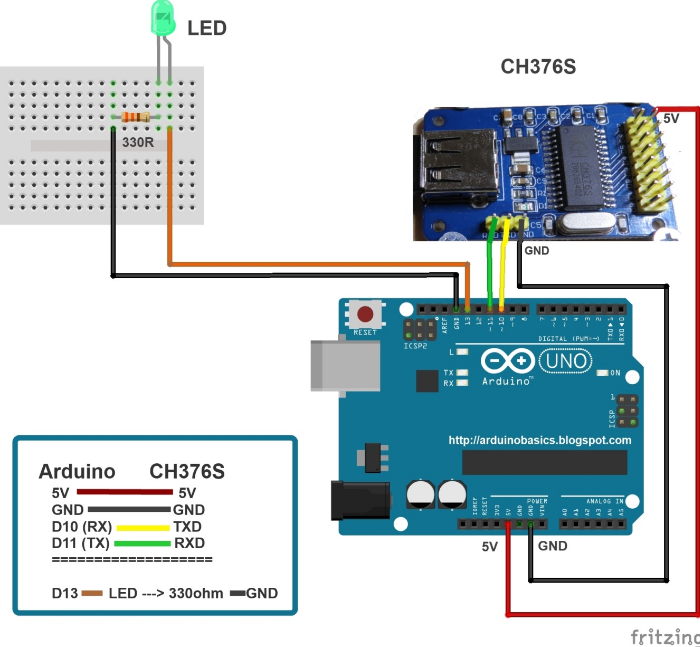 نمونه کد برای راه اندازی ماژول USB Host با آردوینو
نمونه کد برای راه اندازی ماژول USB Host با آردوینو
/* ===============================================================
Project: CH376S USB Read/Write Module testing ground
Author: Scott C
Created: 1st May 2015
Arduino IDE: 1.6.2
Website: http://arduinobasics.blogspot.com/p/arduino-basics-projects-page.html
Description: This project will allow you to perform many of the functions available on the CH376S module.
Checking connection to the module, putting the module into USB mode, resetting the module,
reading, writing, appending text to files on the USB stick. This is very useful alternative to
SD card modules, plus it doesn't need any libraries.
================================================================== */
#include <SoftwareSerial.h>
byte computerByte; //used to store data coming from the computer
byte USB_Byte; //used to store data coming from the USB stick
int LED = 13; //the LED is connected to digital pin 13
int timeOut = 2000; //TimeOut is 2 seconds. This is the amount of time you wish to wait for a response from the CH376S module.
String wrData = "What is the meaning of life ?"; //We will write this data to a newly created file.
String wrData2 = "42"; //We will append this data to an already existing file.
SoftwareSerial USB(10, 11); // Digital pin 10 on Arduino (RX) connects to TXD on the CH376S module
// Digital pin 11 on Arduino (TX) connects to RXD on the CH376S module
// GND on Arduino to GND on CH376S module
// 5V on Arduino to 5V on CH376S module
//==============================================================================================================================================
void setup() {
Serial.begin(9600); // Setup serial communication with the computer (using a baud rate of 9600 on serial monitor)
USB.begin(9600); // Setup serial communication with the CH376S module (using the default baud rate of 9600)
pinMode(LED,OUTPUT); // Define digital pin 13 as an OUTPUT pin - so that we can use it with an LED
digitalWrite(LED,LOW); // Turn off the LED
}
//================================================================================================================================================
void loop() {
if(Serial.available()){
computerByte = Serial.read(); //read any incoming bytes from the Serial monitor, and store this byte in the variable called computerByte
if(computerByte==49){ //1 //If you send the number 1 from the serial monitor, the arduino will read it as digital number 49. Google "ascii table" for more info.
printCommandHeader("COMMAND1: CHECK CONNECTION");
checkConnection(0x01); // Check for successful connection and communication with the CH376S module.
}
if(computerByte==50){ //2
printCommandHeader("COMMAND2: set_USB_Mode");
set_USB_Mode(0x06); // Code used to enable read/write communication and monitoring of the USB stick
}
if(computerByte==51){ //3
printCommandHeader("COMMAND3: resetALL");
resetALL(); // Reset the USB device
}
if(computerByte==52){ //4
printCommandHeader("COMMAND4: Create and Write to File : TEST4.TXT");
writeFile("TEST4.TXT", wrData); // Create a file called TEST4.TXT and then Write the contents of wrData to this file
}
if(computerByte==53){ //5
printCommandHeader("COMMAND5: Read File: TEST4.TXT");
readFile("TEST4.TXT"); // Read the contents of this file on the USB disk, and display contents in the Serial Monitor
}
if(computerByte==54){ //6
printCommandHeader("COMMAND6: Append data to file: TEST4.TXT");
appendFile("TEST4.TXT", wrData2); // Append data to the end of the file.
}
if(computerByte==55){ //7
printCommandHeader("COMMAND7: Delete File: TEST4.TXT");
fileDelete("TEST4.TXT"); // Delete the file named TEST4.TXT
}
if(computerByte==56){ //8
printCommandHeader("COMMAND8: Read File: TEST2.TXT");
readFile("TEST2.TXT"); // Read the contents of the TEST2.TXT file on the USB disk, and display contents in the Serial Monitor
}
if(computerByte==57){ //9
printCommandHeader("COMMAND9: Read File: TEST3.TXT");
readFile("TEST3.TXT"); // Read the contents of the TEST3.TXT file on the USB disk, and display contents in the Serial Monitor
}
}
if(USB.available()){ // This is here to capture any unexpected data transmitted by the CH376S module
Serial.print("CH376S has just sent this code:");
Serial.println(USB.read(), HEX);
}
}
//END OF LOOP FUNCTION ========================================================================================================================================
//print Command header
void printCommandHeader(String header){
Serial.println("======================");
Serial.println("");
Serial.println(header);
Serial.println("----------------------");
}
//checkConnection==================================================================================
//This function is used to check for successful communication with the CH376S module. This is not dependant of the presence of a USB stick.
//Send any value between 0 to 255, and the CH376S module will return a number = 255 - value.
void checkConnection(byte value){
USB.write(0x57);
USB.write(0xAB);
USB.write(0x06);
USB.write(value);
if(waitForResponse("checking connection")){ //wait for a response from the CH376S. If CH376S responds, it will be true. If it times out, it will be false.
if(getResponseFromUSB()==(255-value)){
Serial.println(">Connection to CH376S was successful.");
blinkLED(); //blink the LED for 1 second if the connection was successful
} else {
Serial.print(">Connection to CH376S - FAILED.");
}
}
}
//set_USB_Mode=====================================================================================
//Make sure that the USB is inserted when using 0x06 as the value in this specific code sequence
void set_USB_Mode (byte value){
USB.write(0x57);
USB.write(0xAB);
USB.write(0x15);
USB.write(value);
delay(20);
if(USB.available()){
USB_Byte=USB.read();
//Check to see if the command has been successfully transmitted and acknowledged.
if(USB_Byte==0x51){ // If true - the CH376S has acknowledged the command.
Serial.println("set_USB_Mode command acknowledged"); //The CH376S will now check and monitor the USB port
USB_Byte = USB.read();
//Check to see if the USB stick is connected or not.
if(USB_Byte==0x15){ // If true - there is a USB stick connected
Serial.println("USB is present");
blinkLED(); // If the process was successful, then turn the LED on for 1 second
} else {
Serial.print("USB Not present. Error code:"); // If the USB is not connected - it should return an Error code = FFH
Serial.print(USB_Byte, HEX);
Serial.println("H");
}
} else {
Serial.print("CH3765 error! Error code:");
Serial.print(USB_Byte, HEX);
Serial.println("H");
}
}
delay(20);
}
//resetALL=========================================================================================
//This will perform a hardware reset of the CH376S module - which usually takes about 35 msecs =====
void resetALL(){
USB.write(0x57);
USB.write(0xAB);
USB.write(0x05);
Serial.println("The CH376S module has been reset !");
delay(200);
}
//readFile=====================================================================================
//This will send a series of commands to read data from a specific file (defined by fileName)
void readFile(String fileName){
resetALL(); //Reset the module
set_USB_Mode(0x06); //Set to USB Mode
diskConnectionStatus(); //Check that communication with the USB device is possible
USBdiskMount(); //Prepare the USB for reading/writing - you need to mount the USB disk for proper read/write operations.
setFileName(fileName); //Set File name
fileOpen(); //Open the file for reading
int fs = getFileSize(); //Get the size of the file
fileRead(); //***** Send the command to read the file ***
fileClose(0x00); //Close the file
}
//writeFile========================================================================================
//is used to create a new file and then write data to that file. "fileName" is a variable used to hold the name of the file (e.g TEST.TXT). "data" should not be greater than 255 bytes long.
void writeFile(String fileName, String data){
resetALL(); //Reset the module
set_USB_Mode(0x06); //Set to USB Mode
diskConnectionStatus(); //Check that communication with the USB device is possible
USBdiskMount(); //Prepare the USB for reading/writing - you need to mount the USB disk for proper read/write operations.
setFileName(fileName); //Set File name
if(fileCreate()){ //Try to create a new file. If file creation is successful
fileWrite(data); //write data to the file.
} else {
Serial.println("File could not be created, or it already exists");
}
fileClose(0x01);
}
//appendFile()====================================================================================
//is used to write data to the end of the file, without erasing the contents of the file.
void appendFile(String fileName, String data){
resetALL(); //Reset the module
set_USB_Mode(0x06); //Set to USB Mode
diskConnectionStatus(); //Check that communication with the USB device is possible
USBdiskMount(); //Prepare the USB for reading/writing - you need to mount the USB disk for proper read/write operations.
setFileName(fileName); //Set File name
fileOpen(); //Open the file
filePointer(false); //filePointer(false) is to set the pointer at the end of the file. filePointer(true) will set the pointer to the beginning.
fileWrite(data); //Write data to the end of the file
fileClose(0x01); //Close the file using 0x01 - which means to update the size of the file on close.
}
//setFileName======================================================================================
//This sets the name of the file to work with
void setFileName(String fileName){
Serial.print("Setting filename to:");
Serial.println(fileName);
USB.write(0x57);
USB.write(0xAB);
USB.write(0x2F);
USB.write(0x2F); // Every filename must have this byte to indicate the start of the file name.
USB.print(fileName); // "fileName" is a variable that holds the name of the file. eg. TEST.TXT
USB.write((byte)0x00); // you need to cast as a byte - otherwise it will not compile. The null byte indicates the end of the file name.
delay(20);
}
//diskConnectionStatus================================================================================
//Check the disk connection status
void diskConnectionStatus(){
Serial.println("Checking USB disk connection status");
USB.write(0x57);
USB.write(0xAB);
USB.write(0x30);
if(waitForResponse("Connecting to USB disk")){ //wait for a response from the CH376S. If CH376S responds, it will be true. If it times out, it will be false.
if(getResponseFromUSB()==0x14){ //CH376S will send 0x14 if this command was successful
Serial.println(">Connection to USB OK");
} else {
Serial.print(">Connection to USB - FAILED.");
}
}
}
//USBdiskMount========================================================================================
//initialise the USB disk and check that it is ready - this process is required if you want to find the manufacturing information of the USB disk
void USBdiskMount(){
Serial.println("Mounting USB disk");
USB.write(0x57);
USB.write(0xAB);
USB.write(0x31);
if(waitForResponse("mounting USB disk")){ //wait for a response from the CH376S. If CH376S responds, it will be true. If it times out, it will be false.
if(getResponseFromUSB()==0x14){ //CH376S will send 0x14 if this command was successful
Serial.println(">USB Mounted - OK");
} else {
Serial.print(">Failed to Mount USB disk.");
}
}
}
//fileOpen========================================================================================
//opens the file for reading or writing
void fileOpen(){
Serial.println("Opening file.");
USB.write(0x57);
USB.write(0xAB);
USB.write(0x32);
if(waitForResponse("file Open")){ //wait for a response from the CH376S. If CH376S responds, it will be true. If it times out, it will be false.
if(getResponseFromUSB()==0x14){ //CH376S will send 0x14 if this command was successful
Serial.println(">File opened successfully.");
} else {
Serial.print(">Failed to open file.");
}
}
}
//setByteRead=====================================================================================
//This function is required if you want to read data from the file.
boolean setByteRead(byte numBytes){
boolean bytesToRead=false;
int timeCounter = 0;
USB.write(0x57);
USB.write(0xAB);
USB.write(0x3A);
USB.write((byte)numBytes); //tells the CH376S how many bytes to read at a time
USB.write((byte)0x00);
if(waitForResponse("setByteRead")){ //wait for a response from the CH376S. If CH376S responds, it will be true. If it times out, it will be false.
if(getResponseFromUSB()==0x1D){ //read the CH376S message. If equal to 0x1D, data is present, so return true. Will return 0x14 if no data is present.
bytesToRead=true;
}
}
return(bytesToRead);
}
//getFileSize()===================================================================================
//writes the file size to the serial Monitor.
int getFileSize(){
int fileSize=0;
Serial.println("Getting File Size");
USB.write(0x57);
USB.write(0xAB);
USB.write(0x0C);
USB.write(0x68);
delay(100);
Serial.print("FileSize =");
if(USB.available()){
fileSize = fileSize + USB.read();
}
if(USB.available()){
fileSize = fileSize + (USB.read()*255);
}
if(USB.available()){
fileSize = fileSize + (USB.read()*255*255);
}
if(USB.available()){
fileSize = fileSize + (USB.read()*255*255*255);
}
Serial.println(fileSize);
delay(10);
return(fileSize);
}
//fileRead========================================================================================
//read the contents of the file
void fileRead(){
Serial.println("Reading file:");
byte firstByte = 0x00; //Variable to hold the firstByte from every transmission. Can be used as a checkSum if required.
byte numBytes = 0x40; //The maximum value is 0x40 = 64 bytes
while(setByteRead(numBytes)){ //This tells the CH376S module how many bytes to read on the next reading step. In this example, we will read 0x10 bytes at a time. Returns true if there are bytes to read, false if there are no more bytes to read.
USB.write(0x57);
USB.write(0xAB);
USB.write(0x27); //Command to read ALL of the bytes (allocated by setByteRead(x))
if(waitForResponse("reading data")){ //Wait for the CH376S module to return data. TimeOut will return false. If data is being transmitted, it will return true.
firstByte=USB.read(); //Read the first byte
while(USB.available()){
Serial.write(USB.read()); //Send the data from the USB disk to the Serial monitor
delay(1); //This delay is necessary for successful Serial transmission
}
}
if(!continueRead()){ //prepares the module for further reading. If false, stop reading.
break; //You need the continueRead() method if the data to be read from the USB device is greater than numBytes.
}
}
Serial.println();
Serial.println("NO MORE DATA");
}
//fileWrite=======================================================================================
//are the commands used to write to the file
void fileWrite(String data){
Serial.println("Writing to file:");
byte dataLength = (byte) data.length(); // This variable holds the length of the data to be written (in bytes)
Serial.println(data);
Serial.print("Data Length:");
Serial.println(dataLength);
delay(100);
// This set of commands tells the CH376S module how many bytes to expect from the Arduino. (defined by the "dataLength" variable)
USB.write(0x57);
USB.write(0xAB);
USB.write(0x3C);
USB.write((byte) dataLength);
USB.write((byte) 0x00);
if(waitForResponse("setting data Length")){ // Wait for an acknowledgement from the CH376S module before trying to send data to it
if(getResponseFromUSB()==0x1E){ // 0x1E indicates that the USB device is in write mode.
USB.write(0x57);
USB.write(0xAB);
USB.write(0x2D);
USB.print(data); // write the data to the file
if(waitForResponse("writing data to file")){ // wait for an acknowledgement from the CH376S module
}
Serial.print("Write code (normally FF and 14): ");
Serial.print(USB.read(),HEX); // code is normally 0xFF
Serial.print(",");
USB.write(0x57);
USB.write(0xAB);
USB.write(0x3D); // This is used to update the file size. Not sure if this is necessary for successful writing.
if(waitForResponse("updating file size")){ // wait for an acknowledgement from the CH376S module
}
Serial.println(USB.read(),HEX); //code is normally 0x14
}
}
}
//continueRead()==================================================================================
//continue to read the file : I could not get this function to work as intended.
boolean continueRead(){
boolean readAgain = false;
USB.write(0x57);
USB.write(0xAB);
USB.write(0x3B);
if(waitForResponse("continueRead")){ //wait for a response from the CH376S. If CH376S responds, it will be true. If it times out, it will be false.
if(getResponseFromUSB()==0x14){ //CH376S will send 0x14 if this command was successful
readAgain=true;
}
}
return(readAgain);
}
//fileCreate()========================================================================================
//the command sequence to create a file
boolean fileCreate(){
boolean createdFile = false;
USB.write(0x57);
USB.write(0xAB);
USB.write(0x34);
if(waitForResponse("creating file")){ //wait for a response from the CH376S. If file has been created successfully, it will return true.
if(getResponseFromUSB()==0x14){ //CH376S will send 0x14 if this command was successful
createdFile=true;
}
}
return(createdFile);
}
//fileDelete()========================================================================================
//the command sequence to delete a file
void fileDelete(String fileName){
setFileName(fileName);
delay(20);
USB.write(0x57);
USB.write(0xAB);
USB.write(0x35);
if(waitForResponse("deleting file")){ //wait for a response from the CH376S. If file has been created successfully, it will return true.
if(getResponseFromUSB()==0x14){ //CH376S will send 0x14 if this command was successful
Serial.println("Successfully deleted file");
}
}
}
//filePointer========================================================================================
//is used to set the file pointer position. true for beginning of file, false for the end of the file.
void filePointer(boolean fileBeginning){
USB.write(0x57);
USB.write(0xAB);
USB.write(0x39);
if(fileBeginning){
USB.write((byte)0x00); //beginning of file
USB.write((byte)0x00);
USB.write((byte)0x00);
USB.write((byte)0x00);
} else {
USB.write((byte)0xFF); //end of file
USB.write((byte)0xFF);
USB.write((byte)0xFF);
USB.write((byte)0xFF);
}
if(waitForResponse("setting file pointer")){ //wait for a response from the CH376S.
if(getResponseFromUSB()==0x14){ //CH376S will send 0x14 if this command was successful
Serial.println("Pointer successfully applied");
}
}
}
//fileClose=======================================================================================
//closes the file
void fileClose(byte closeCmd){
Serial.println("Closing file:");
USB.write(0x57);
USB.write(0xAB);
USB.write(0x36);
USB.write((byte)closeCmd); // closeCmd = 0x00 = close without updating file Size, 0x01 = close and update file Size
if(waitForResponse("closing file")){ // wait for a response from the CH376S.
byte resp = getResponseFromUSB();
if(resp==0x14){ // CH376S will send 0x14 if this command was successful
Serial.println(">File closed successfully.");
} else {
Serial.print(">Failed to close file. Error code:");
Serial.println(resp, HEX);
}
}
}
//waitForResponse===================================================================================
//is used to wait for a response from USB. Returns true when bytes become available, false if it times out.
boolean waitForResponse(String errorMsg){
boolean bytesAvailable = true;
int counter=0;
while(!USB.available()){ //wait for CH376S to verify command
delay(1);
counter++;
if(counter>timeOut){
Serial.print("TimeOut waiting for response: Error while: ");
Serial.println(errorMsg);
bytesAvailable = false;
break;
}
}
delay(1);
return(bytesAvailable);
}
//getResponseFromUSB================================================================================
//is used to get any error codes or messages from the CH376S module (in response to certain commands)
byte getResponseFromUSB(){
byte response = byte(0x00);
if (USB.available()){
response = USB.read();
}
return(response);
}
//blinkLED==========================================================================================
//Turn an LED on for 1 second
void blinkLED(){
digitalWrite(LED, HIGH);
delay(1000);
digitalWrite(LED,LOW);
}
دانلود دیتاشیت ماژول USB HOST تراشه CH376S
برخی از کامند های پر کاربرد ماژول
برای کار با برنامه کافی است ترمینال آردوینو را باز کنید و کامند ها را از طریق آن ارسال کنید.
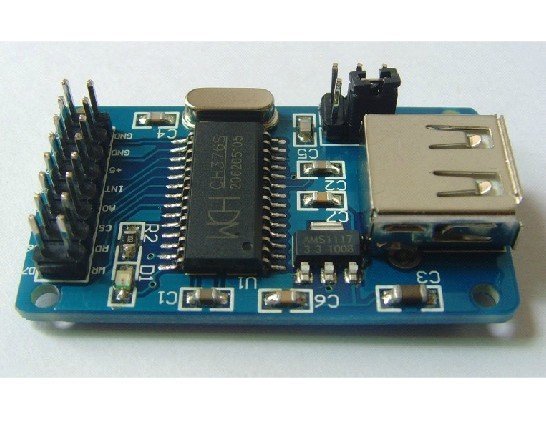

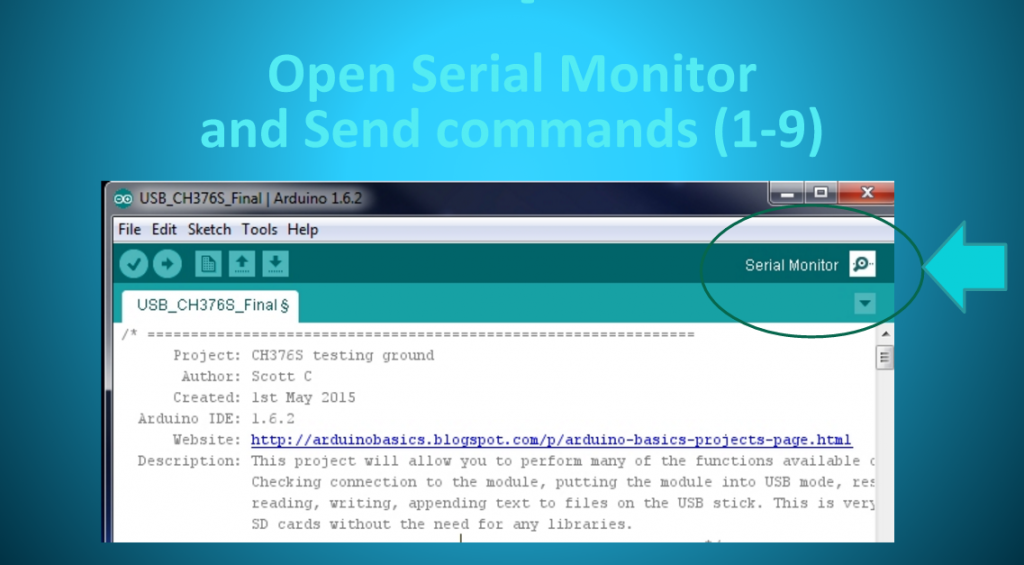



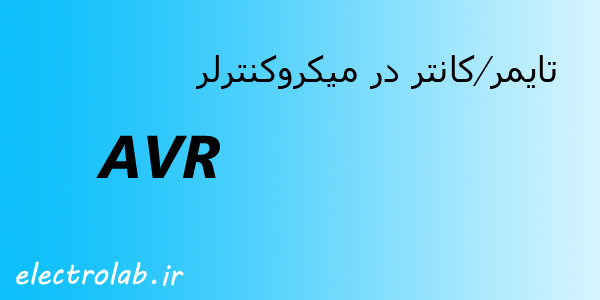
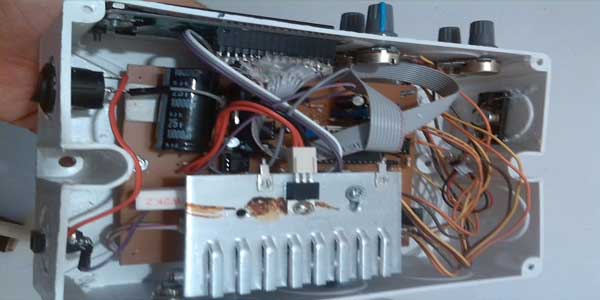
سلام
وقتتون بخیر
ببخشید یه سوال
ماژولی داریم که واسه راه اندازی هارددیسک استفاده بشه ؟
آخه این ماژول تا حجم 32 گیگ استفاده میشه
اگه ماژول نیست حتما باید یه راهی باشه
با میکرو Arm یا هر میکروی دیگری شاید بشه کاری کرد
ممنون میشم راهنمایی کنین
باتشکر
اطلاعات چندانی در این مورد ندارم
سلام.
من میخوام تو برنامه کیپداطلاعاتی که وارد میکنمو با سریال بفرستم به فلش.
ماژولشم گرفتم ولی هرکاری کردم نتونستم بفرستمش به فلش. میشه کمکم کنین. مرسی
sh376s ماژولمه